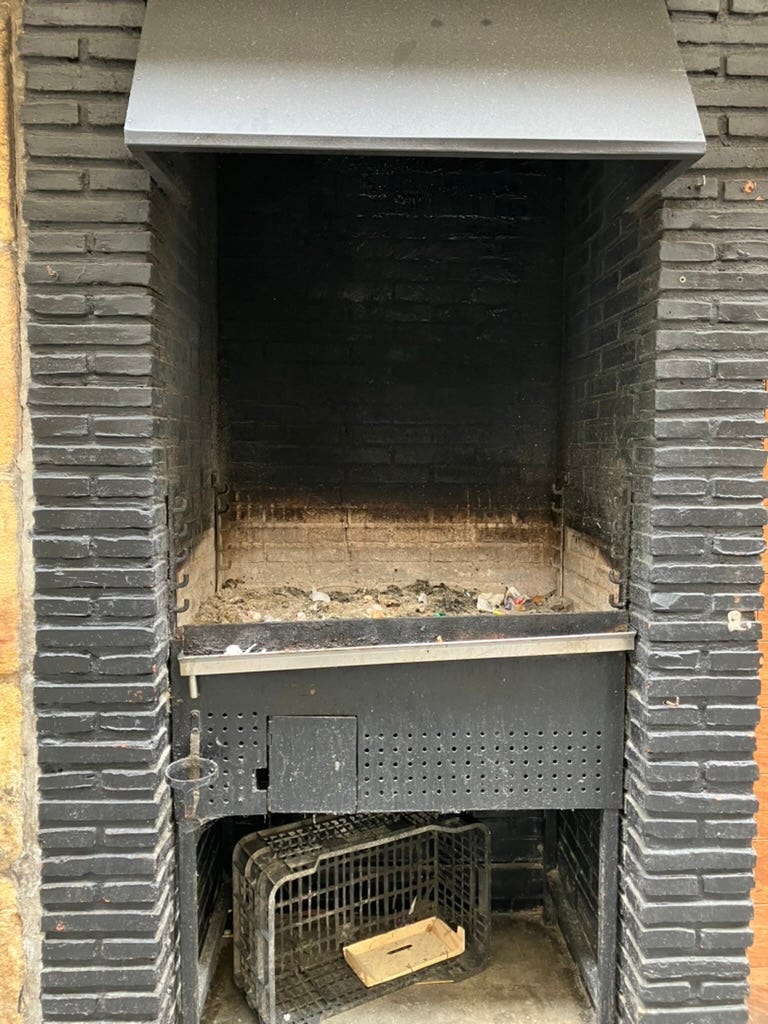In my next life, I want to be this parillero in Getaria, who might have the most beautiful station in the world.
When I took this photo, he and I were standing on the same cobblestones, overlooking the harbor. On this part of the Spanish coast you can fall off a hillside into the sea, and the water was as far below us as it was behind. Four turbots are lined up on the table to the right. I wondered if he’d ever, on a bad day, been overcome by the temptation to pitch one of his mistakes back into the water whence it came.
We were in Getaria (pop. 2,818) to eat at one of its asadors, restaurants specializing in grilled seafood. There isn’t much else for a visitor to do, other than surf, or marvel at the view, and you can do your marveling from the table, since most of the asadors face the harbor.
The story – recent enough to be a living memory – goes that asadors evolved from sailors’ cooking. Local fishing boats had long carried charcoal grills so their crews could feed themselves. It being an eternal truth that people drink more if they’re also eating, the dockside bars (and Getaria is all dockside) began to build similar grills on their exterior walls so their patrons would linger there, cooking their own catch. Once the grills started attracting the attention of other passers-by, asadors were the logical conclusion (this history is drawn entirely from Raphael Tonon's excellent guide).
We actually did eat that parrillero’s handiwork, sitting not 10 meters from his grill. Lunch was a tour of the Bay of Biscay: a conserva of tuna; clams in parsley; kokotxas from fish of different sizes; a fish soup of fathomless depth; and a dense, muscular rockfish swimming once more in pil pil, charred and crisp at the edges, almost crustacean within – and this asador, which had begun as a simple bar, wasn’t even supposed to be the best in town (that one, of course, is the victim of a Michelin star).
This was autochthonous cooking, supposedly unchanged from the days when the cooks were sailors still covered in scales, inseparable from the grills in the streets and the merger of village and sea. It tasted elemental, absolute.
But we’d been greeted by beblazered hosts in a dining room paneled in oak and brass, and our food was brought by a flotilla of servers sailing around in crisp aprons and billowing shirts, sculptural dishes set down on tablecloths of fluid grey linen that matched the cobblestones, the servers’ shirts, and the zinc-bar sky. The quality of the cooking, it seemed, demanded the dining room rigmarole, or perhaps the prices did, or perhaps the simple fact that this was supposed to be the second “best” restaurant in town. None of this interfered with our delight in lunch, but equally, this didn’t seem like any place for ornament.
In that, it reminded me of a restaurant in Singapore, 11,183km away: the world’s most visible Peranakan restaurant, Candlenut, where a team of 25 cooks grind all the rempah-rempah by hand. Insofar as one can generalize about an entire cuisine, I’d probably have to describe Peranakan cooking as the polar opposite of the food in Getaria. Peranakan cuisine is deeply creolized whereas the cuisine of the asadors shows almost no influences from outside the region. It’s primarily a cuisine of the home while parillas mostly occupy public space. It was elaborated and transmitted primarily by women rather than men. It’s labor intensive, almost baroque, whereas asadors have roots in the expediency of shipboard cooking. And yet when you eat at Candlenut, the servers wear aprons and shirts, the napkins are starched, the setting is grand, and all this feels as congruent with the food as bone china in a fishing port bar.
This is curiously convergent evolution. It’s not only that the commitment to good cooking seems to require dressing up; it’s that the trappings are identical – coursed service, people in suits, heavier menus. What caused restaurants with such different cuisines and milieus to evolve the same resplendent tails and scimitar beaks?
Lunch ended with a farmer’s dessert: an unsweetened sheep’s milk junket, serene and faintly animal, served with a dish of plain sugar alongside. Because we were in Spain, we ordered flan as well. It landed with a textbook quiver, and companion vanilla ice cream was so pure and light it was almost severe. The hills around Getaria are chequered with vines and pastures, and whether it’s the light or the vegetation, lushness has a different green in different places. We spent the afternoon walking around the village, main streets the size of a New York alley. Parillas still peek out from the walls, and they all showed recent use.





Very nice writing , made me want to go there